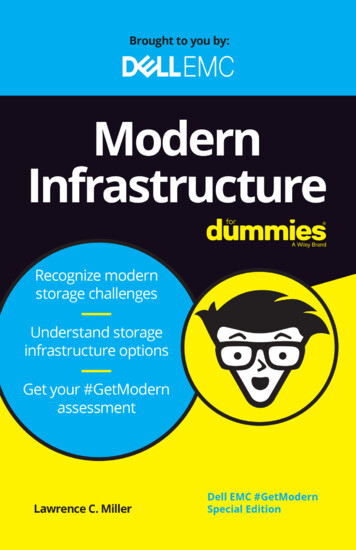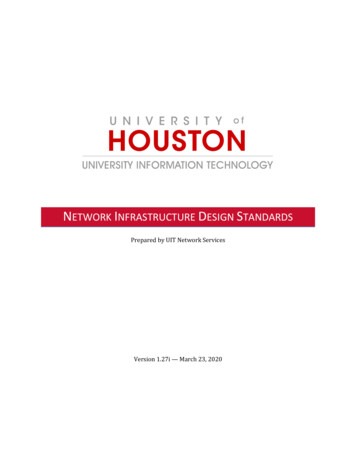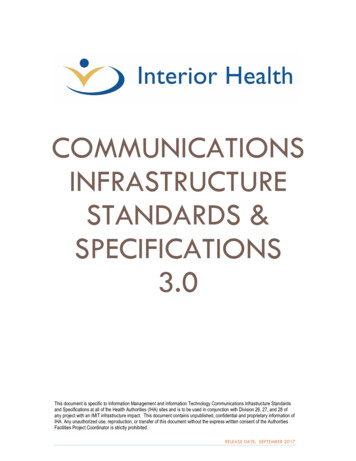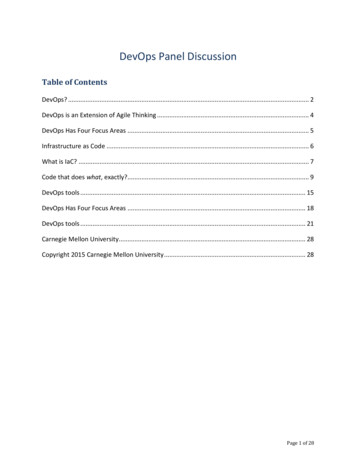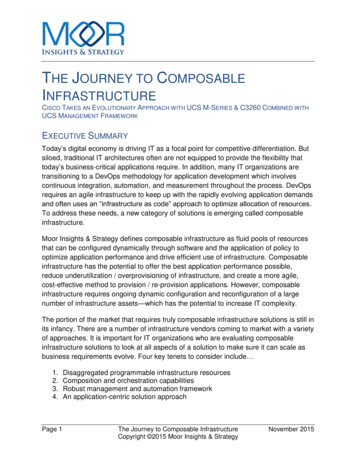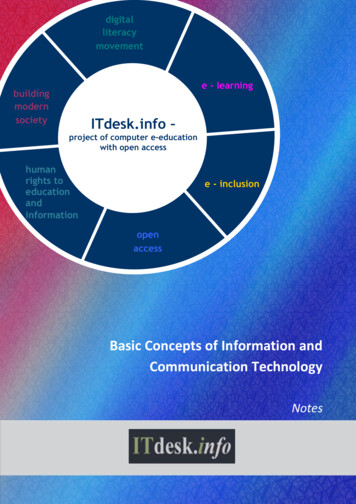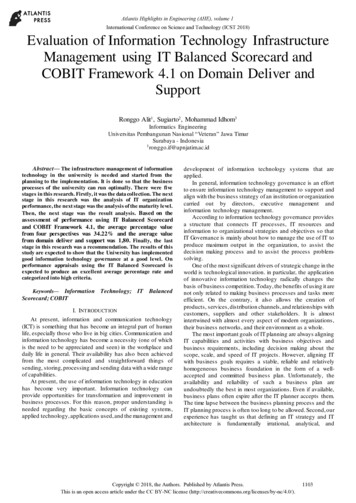
Transcription
Atlantis Highlights in Engineering (AHE), volume 1International Conference on Science and Technology (ICST 2018)Evaluation of Information Technology InfrastructureManagement using IT Balanced Scorecard andCOBIT Framework 4.1 on Domain Deliver andSupportRonggo Alit1 , Sugiarto2 , Mohammad Idhom3Informatics EngineeringUniversitas Pembangunan Nasional “Veteran” Jawa TimurSurabaya - Indonesia1ronggo.if@upnjatim.ac.idAbstract— The infrastructure management of informationtechnology in the university is needed and started from theplanning to the implementation. It is done so that the businessprocesses of the university can run optimally. There were fivestages in this research. Firstly, it was the data collection. The nextstage in this research was the analysis of IT organizationperformance, the next stage was the analysis of the maturity level.Then, the next stage was the result analysis. Based on theassessment of performance using IT Balanced Scorecardand COBIT Framework 4.1, the average percentage valuefrom four perspectives was 34.22% and the average valuefrom domain deliver and support was 1,80. Finally, the laststage in this research was a recommendation. The results of thisstudy are expected to show that the University has implementedgood information technology governance at a good level. Onperformance appraisals using the IT Balanced S corecard isexpected to produce an excellent average percentage rate andcategorized into high criteria.Keywords— Information Technology; ITScorecard; COBITBalancedI. INT RODUCT IONAt present, information and communication technology(ICT) is something that has become an integral part of humanlife, especially those who live in big cities. Communication andinformation technology has become a necessity (one of whichis the need to be appreciated and seen) in the workplace anddaily life in general. Their availability has also been achievedfrom the most complicated and straightforward things ofsending, storing, processing and sending data with a wide rangeof capabilities.At present, the use of information technology in educationhas become very important. Information technology canprovide opportunities for transformation and improvement inbusiness processes. For this reason, proper understanding isneeded regarding the basic concepts of existing systems,applied technology, applications used, and the management anddevelopment of information technology systems that areapplied.In general, information technology governance is an effortto ensure information technology management to support andalign with the business strategy of an institution or organizationcarried out by directors, executive management andinformation technology management.According to information technology governance providesa structure that connects IT processes, IT resources andinformation to organizational strategies and objectives so thatIT Governance is mainly about how to manage the use of IT toproduce maximum output in the organization, to assist thedecision making process and to assist the process problemsolving.One of the most significant drivers of strategic change in theworld is technological innovation. in particular, the applicationof innovative information technology radically changes thebasis of business competition. Today, the benefits of using it arenot only related to making business processes and tasks moreefficient. On the contrary, it also allows the creation ofproducts, services, distribution channels, and relationships withcustomers, suppliers and other stakeholders. It is almostintertwined with almost every aspect of modern organizations,their business networks, and their environment as a whole.The most important goals of IT planning are always aligningIT capabilities and activities with business objectives andbusiness requirements, including decision making about thescope, scale, and speed of IT projects. However, aligning ITwith business goals requires a stable, reliable and relativelyhomogeneous business foundation in the form of a wellaccepted and committed bus iness plan. Unfortunately, theavailability and reliability of such a business plan areundoubtedly the best in most organizations. Even if available,business plans often expire after the IT planner accepts them.The time lapse between the business planning process and theIT planning process is often too long to be allowed. Second, ourexperience has taught us that defining an IT strategy and ITarchitecture is fundamentally irrational, analytical, andCopyright 2018, the Authors. Published by Atlantis Press.This is an open access article under the CC BY-NC license 103
Atlantis Highlights in Engineering (AHE), volume 1certainly not technical. Success potential depends very much onthe communication skills of all involved. In manyorganizations, business managers and IT planners have shownthat they cannot express themselves in the same language,needed to overcome the absence of rationality and analysis sothat successful relationships between business goals, ITstrategies, and IT architecture are not sufficiently built.[1]II. RELAT ED WORKSA. IT Balanced ScorecardAccording to [2] the Balanced Scorecard concept developedby Kaplan and Norton can be implemented into the IT functionsand processes that have led to the concept of Balance ScorecardInformation Technology. The implementation of BalancedScorecard in the IT function becomes an increasingly populartool used by many institutions. The Balanced Scorecard IT isdivided into four factors, namely: Corporate Contribution Customer Orientation Operational Excellent Future OrientationThe traditional BSC looks at four dimensions of thecompany: Finance, Customers, Internal Business Processes,Learning and Growth. This can certainly be used in strategicplanning. New IT BSC proposes four other perspectives:Corporate Contribution, Customer Orientation, OperationalExcellence, Future Orientation.First perspective - Corporate Contribution represents thevalue of a business built thanks to IT investments. Next Customer (User) Orientation shows user evaluation of IT.Another perspective - Operational excellence shows the ITprocess that is implemented to develop and deliverapplications. The last perspective - Future Orientation showstechnology and human resources that are urgently needed bythe IT department to provide timely services [3]to monitor and guide specific projects and efforts to improvegeneral performance. A balanced IS scorecard will allowmanagers to see the positive and negative impacts of ITapplications and IS activities on important factors for theorganization as a whole. The value of balanced IS scorecardsincreases when used to coordinate various IS managementprocesses, such as individual and team goal settings,performance appraisals and rewards for IS personnel, resourceallocation, and feedback-based learning.Some research findings show the link between IT BalancedScorecard and COBIT 4.1 Framework in measuringinformation technology governance, research conducted by [5]which states that the scope of COBIT self-assessment isdetermined by business objectives, IT objectives and domainprocesses in COBIT. The limitations of business goals are inthe four perspectives of the Balanced Scorecard.B. Control Objective for Information and Related Technology(COBIT)COBIT is an audit of information systems and control basescreated by the Information and Control Systems AuditAssociation (ISACA) and the Information TechnologyGovernance Institute (ITGI) in 1992 to provide informationneeded by institutions in achieving their objectives [6].COBIT has a comprehensive scope, and not allorganizations have an overall process. Each institution has awide range and reaches of useful information technology. Notall steps in COBIT can be applied, the institution needs onlycertain parts. Along with what was explained by [6], thisstandard does not require an application of all components butcan choose relevant parts. The image below shows the COBITprocess:Fig. 1. T he change of T he T raditional IT Balanced ScorecardPerspectiveintoT he IT Balanced Scorecard Perspective [3]Research conducted by [4] explained that this studyrecommends determining whether the proposed perspectivesand measures are needed in assessing. However, thisframework is a strategic IS management tool that can be usedFig. 2. COBIT Framework [6]1104
Atlantis Highlights in Engineering (AHE), volume 1The COBIT framework was developed by the ITGovernance Institute, an organization that researches ITmanagement models based in the United States. The COBITframework consists of four main domains [6]: Planning & Organization.This domain focuses on the process of planning andaligning the IT strategy with the strategy of theinstitution. Acquisition & Implementation.This domain focuses on the process of selection,procurement, and application of the implementedinformation technology. Delivery & Support.This domain focuses on the process of IT service andits technical support. Monitoring & Evaluate.This domain focuses on the process of IT managementsupervision in the organization.The Control Objectives for Information and relatedTechnology (COBIT) is one of the standards in IT governancedeveloped to help companies control business needs that coverall information technology activities and emphasize what mustbe adequately resolved and monitored [7].Next research was conducted by [8] The search thereexplains that the ICT-based model is a model for the maturitylevel of a school. The proposed model is called ICTE-MM andit has three supporting elements: elements of the educationprocess, information criteria for ICT resources and domainleverage. The main benefits of ICTE-MM are the terms ofreference for identifying areas that support the ICTE-MMstrategy based on international standardization of educationICT management.III. M ET HODOLOGYData collection is done to obtain the information needed toachieve the research objectives. The achievement of thematurity level of the current IT infrastructure is based onwritten data such as Quality Objectives Reports, Strategic PlanReports for ICT Development, Information TechnologyBlueprint.In the current stage of technology analysis, the level ofmaturity of information technology infrastructure (as is),researchers assess each model of the maturity attribute for theprocess being assessed. Assessment of the current maturitylevel (as-is) is obtained based on the achievement of thematurity level of the existing information technologyinfrastructure based on written data such as Quality ObjectivesReports, Strategic Plan Reports for ICT Development, BlueInformation Technology Print University. Assessment of theexpected level of maturity (to-be) aims to provide referencesfor the development of information technology governance inthe institution. In the step of the analysis, the researcherconducted a study that is by combining the results obtainedfrom the report of the performance of information technologyorganizations and the analysis of information technologyinfrastructure maturity level.Fig. 3. Stages ResearchIV. RESULT AND DISCUSSIONA. The Performance Appraisal based on the IT BalancedScorecardBased on data management and information technologyuser surveys obtained by researchers in measuring andanalyzing the level of IT support using the IT BalancedScorecard, there are four perspectives: company contribution,user orientation, operational improvement, and futureorientation.The company's contribution perspective has four strategicobjectives. Table, I shows that the first and second are thecontrol of IT and IT costs and business objectives. Furthermore,the third goal is the business value of IT functions , and thefourth goal is the effectiveness of IT work units. The userorientation perspective has four strategic objectives. The first isproduct quality, the second is user contribution, the third is usersatisfaction, and the fourth is user interaction with IT workunits.Furthermore, the perspective of operational improvementhas four strategic objectives. The first strategic objective in thisperspective is the effectiveness of application development.Furthermore, the second is the intensity of systemmaintenance. Then, the third strategic objective is theeffectiveness of service functions. Finally, the fourth strategicgoal in this perspective is to increase accuracy.The future orientation perspective also has four strategicobjectives. The first strategic objective is the training budget forIT personnel. Then, the second strategic goal is the expertise ofIT personnel. Third, the next strategic objective is the budget1105
Atlantis Highlights in Engineering (AHE), volume 1for IT Research and Development. Finally, the fourth strategicgoal is IT Product Innovation.The Main Performance Indicator (KPI) of the IT BalancedScorecard is shown in the table below:The result of the average calculation from the DS domain(Deliver and Support) was shown in Table IV:TABLE IV.TABLE I.KPI OF IT BALANCED SCORECARDPe rspe ctive of CompanyContributionT he IT budged controlT he IT and business objectivesT he business value of ITT he effectiveness of IT working unitPe rspe ctive of ope rationalimprove me ntT he effectiveness of applicationdevelopmentT he intensity system maintenanceT he effectiveness of service functionT he improvement accuracyPerspective of User’sO rientationT he product qualityT he user’s contributionT he user’s satisfactionT he interaction of use’s with ITworking unitPerspective of futureorientationT he training budget for ITpersonnelT he expertise of IT personnelT he budget of IT research anddevelopmentT he IT product innovationThe Balanced Scorecard calculation of the total IT value inTable II shows that the performance appraisal shows theperspective of the company's contribution of 34.18%. Thisvalue indicates poor criteria because the value obtained is lessthan 50%. The results of performance appraisal in a useroriented perspective show a value of 31.68%, which indicatesthe criteria of the poor. That's because the value obtained is lessthan 50%. The results of the performance appraisal in the repairoperation perspective show a value of 38.33% and the valuealso indicates the criteria of the poor. That's because the valueobtained is less than 50%. The results of performanceevaluation in a future-oriented perspective show a value of32.72%. The Balanced Scorecard IT performance is shown inthe table below:TABLE II. T OTAL VALUE OF IT BALANCED SCORECARDPe rspectivePerspective of company contributionPerspective of user’s orientationPerspective of operational improvementPerspective of future orientationT otal performancePerformance34.18 %31.68 %38.33 %32.72 %34.22 %It showed the value of total performance was 34.22% andwhich was categorized into low criteria because the value wasrelatively small and the percentage was less than 50%.B. The Calculation of Maturity LevelThe analysis was conducted in the mapping stage based onthe supporting data relating to the Information TechnologyInfrastructure such as the ICT Development Strategic Plan andThe Blue Print of Information Systems. Based on the mapping,it was concluded that there were five domains involved, inTable III shows that the evaluation process namely:TABLE III.T HE EVALUATION P ROCESS OF I NFORMATIONT ECHNOLOGYIT DomainDelivery and supportT HE RESULT OF AVERAGE CALCULATION IN DS (DELIVERAND SUP P ORT) DOMAINDS3DS7DS8DS11DS13Domain RemarksM anage performance capacityEducate and train usersM anage service desk andincidentsM anage dataM anage d on the table above, we can see at the maturity levelof the current condition for DS3, DS7, DS8, DS11, and DS13is 1.80, the average value is 2 (repetitive but intuitive) whichmeans the organization has a repetitive pattern associated withmanagement activities related to information technologygovernance, but its existence is not well defined, and formalinconsistencies still occur.After conducting an assessment to determine the currentlevel, gap analysis for the expected maturity level is the sameas 3. This analysis is expected to provide facilities fororganizations related to information technology. The value of"3" will be achieved about several things, including the level oforganizational readiness, management of human and financialresources and many improvements made in various fields.Table V shows that the gap between the current and expectedmaturity levels:TABLE V.DomainDelivery andsupportGAP ANALYSISCurrentExpected1.803.00AverageGAP Analysis3.00-1.80 1.201.20V. CONCLUSIONBased on the research that has been done, it can beconcluded as follows:1. From the results of the study that has been done showsthe total performance value is 34.22% and which arecategorized as low criteria because the value isrelatively small and the presentation is less than 50%.At the maturity level of the current condition for DS3,DS7, DS8, DS11, and DS13 are 1.80, which obtain anaverage value of 2 (repetitive but intuitive), whichmeans the institution has a pattern that repeatedlyperforms activities related to the management ofinformation technology governance, but its existencehas not been well defined and formal so that theyexperience inconsistencies.2. From this research will produce recommendations thatif it can help for development or can be done as areference for improvement in related matters .IT ProcessDS3, DS7, DS8, DS11, DS131106
Atlantis Highlights in Engineering (AHE), volume 1A CKNOWLEDGMENTThe authors would like to thank the University OfPembangunan Nasional “Veteran” Jawa Timur, especially forthe Informatics Engineering Department and the Faculty ofComputer Science to provide financial support for this Research.[4]REFERENCES[6][1][2][3]J.T .M.V.D. Zee and B. De Jong, “Alignment Is Not Enough:IntegratingBusiness and Information T echnology Management with the BalancedBusiness Scorecard Alignment Is Not Enough : Integrating BusinessandInformation T echnology Management with the Balanced BusinessScorecard,” Journal Journal of Management Information Systems, 16(2),pp. 137-158, December 2015.B.W. Van Grembergen and S. De Haes, “Measuring and Improving ITGovernance,” Information Systems Control Journal, 2005.J. Swierk and M. Mulawa, “IT Balanced Scorecard As A Significant[5][7][8]Component Of Competitive And Modern Company,”Portoroz,SloveniaInternational Conference, pp. 821–829, June 2014.M. Martinsons, R. Davison, and D. T se, “T he balanced scorecard : afoundation for the strategic management of information systems,”Decision Support Systems, 25(1), pp. 71-88, February 1999.M. Sadikin, H. Hardi, and W. H. Haji, “IT Governance Self Assessmentin Higher Education Based on COBIT Case Study : the University ofMercu Buana,” Journal of Advanced Management Science,2(2),pp.83–87, June 2014.IT Governance Institute, Cobit 4.1 Framework Control ObjectivesManagement Guidelines Maturity Models, Rolling Meadows, IL: ITGovernance Institute, 2007.G. Ayu, T . Krisanthi, I.M. Sukarsa, and I.P.A. Bayupati, “ GovernanceAudit Of Application Procurement ,” Journal of T heoreticalandAppliedInformation T echnology, 59(2), pp. 342–351, January 2014.M. Solar, J. Sabattin, and V. Parada, “A Maturity Model for Assessingthe Use of ICT in School Education,” Journal of EducationalTechnology& Society, vol. 16, pp. 206–218, January 2013.1107
Scorecard and COBIT 4.1 Framework in measuring information technology governance, research conducted by [5] which states that the scope of COBIT self-assessment is determined by business objectives, IT objectives and domain processes in COBIT. The limitations of business goals are in the four perspectives of the Balanced Scorecard.
